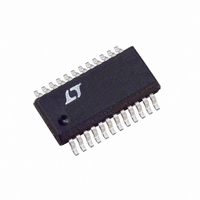LTC1702IGN#TR Linear Technology, LTC1702IGN#TR Datasheet - Page 23

LTC1702IGN#TR
Manufacturer Part Number
LTC1702IGN#TR
Description
IC REG SW DUAL SYNC 2PH 24SSOP
Manufacturer
Linear Technology
Series
PolyPhase®r
Type
Step-Down (Buck)r
Datasheet
1.LTC1702CGN.pdf
(36 pages)
Specifications of LTC1702IGN#TR
Internal Switch(s)
No
Synchronous Rectifier
Yes
Number Of Outputs
2
Current - Output
1A, 25A
Frequency - Switching
550kHz
Voltage - Input
3 ~ 7 V
Operating Temperature
-40°C ~ 85°C
Mounting Type
Surface Mount
Package / Case
24-SSOP
Lead Free Status / RoHS Status
Contains lead / RoHS non-compliant
Voltage - Output
-
Power - Output
-
Available stocks
Company
Part Number
Manufacturer
Quantity
Price
APPLICATIONS
nodes don’t corrupt the measurements or damage the
analyzer.
If breadboard measurement is not practical, a SPICE
simulation can be used to generate approximate gain/
phase curves. Plug the expected capacitor, inductor and
MOSFET values into the following SPICE deck and gener-
ate an AC plot of V(V
V(OUT) in degrees. Refer to your SPICE manual for details
of how to generate this plot.
*1702 modulator gain/phase
*
*this file written to run with PSpice 8.0
*may require modifications for other SPICE
simulators
*MOSFETs
rfet mod sw 0.02
*inductor
lext sw out1 1u
rl out1 out 0.005
*output cap
cout out out2 1000u
resr out2 0 0.01
*1702 internals
emod mod 0 comp 0 5
vstim comp 0 0 ac 1
.ac dec 100 1k 1meg
.probe
.end
With the gain/phase plot in hand, a loop crossover fre-
quency can be chosen. Usually the curves look something
like Figure 8. Choose the crossover frequency in the rising
or flat parts of the phase curve, beyond the external LC
poles. Frequencies between 10kHz and 50kHz usually
work well. Note the gain (GAIN, in dB) and phase (PHASE,
in degrees) at this point. The desired feedback amplifier
gain will be – GAIN to make the loop gain 0dB at this
frequency. Now calculate the needed phase boost, assum-
ing 60° as a target phase margin:
If the required BOOST is less than 60°, a type 2 loop can
be used successfully, saving two external components.
BOOST values greater than 60° usually require type 3
loops for satisfactory performance.
©
1999 Linear Technology
BOOST = – (PHASE + 30°)
U
OUT
INFORMATION
)/V(COMP) in dB and phase of
U
;MOSFET rdson
;inductor value
;inductor series R
;capacitor value
;capacitor ESR
;3.3 for 3.3V supply
;ac stimulus
W
U
Finally, choose a convenient resistor value for R1 (10k is
usually a good value). Now calculate the remaining values:
(K is a constant used in the calculations)
ƒ = chosen crossover frequency
G = 10
gain)
Type 2 Loop:
Type 3 Loop:
K Tan
C
C
R
R
K Tan
C
C
R
R
C
R
1
1
2
2
B
2
2
3
3
B
=
=
=
=
=
=
=
=
=
=
(GAIN/20)
=
=
C K
C K
2
2
( )
2
2
2
V
V
2
2
K
πƒ
πƒ
πƒ
πƒ
πƒ
OUT
OUT
( )
V
( )
R
V
⎛
⎜
⎝
2
K
–
REF
REF
K
1
1
BOOST
⎛
⎜
⎝
GKR
GR
2
C
C
1
1
–
1
BOOST
1
1
–
K R
–
–
(this converts GAIN in dB to G in absolute
1
( )
( )
2
1
R
R
1
V
V
4
1
1
REF
1
REF
3
+
+
45
45
°
⎞
⎟
⎠
°
⎞
⎟
⎠
LTC1702
23
1702fa













